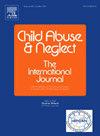家庭富裕和欺凌受害影响肥胖青少年的生活满意度:来自37个高收入国家的证据。
IF 3.4
2区 心理学
Q1 FAMILY STUDIES
引用次数: 0
摘要
背景:体型较大的青少年经常遭受欺凌,这可能会影响他们的整体健康。然而,关于欺凌受害者如何影响这群青少年的整体生活满意度,以及家庭富裕如何调节这种关系的研究有限。目的:探讨家庭富裕程度在大体型青少年欺凌受害与生活满意度之间的调节作用。背景和参与者:根据世界卫生组织的身体质量指数表/分类,这项研究涉及来自欧洲和北美37个高收入国家的16240名体型较大的青少年,年龄在13至15岁之间。设计:该研究使用了学龄儿童健康行为调查(HBSC)的数据,这是一项关于青少年健康和福祉的跨国研究。通过随机截距的混合效应二元logit模型评估假设,考虑数据聚类和区域差异。结果:控制协变量后,网络欺凌(AOR = 1.72;95% CI = 1.48-2.00)和传统欺凌(AOR = 1.74, 95% CI: 1.53-1.99)与没有欺凌经历的参与者的生活满意度显著相关。家庭富裕程度在一定程度上调节了这些关联,其中,与较低水平相比,最高水平的富裕程度降低了网络欺凌(AOR = 1.57, 95% CI: 1.09-2.27)和传统欺凌(AOR = 1.41, 95% CI: 1.02-1.96)对生活满意度的影响。结论:传统欺凌和网络欺凌均显著降低了体型较大的青少年的生活满意度。然而,较高的家庭富裕程度缓和(减少)了这些负面影响,表明社会经济地位起着保护作用。这些发现强调需要采取有针对性的干预措施,以支持受欺凌的青少年,特别是那些体型较大和社会经济背景较低的青少年。本文章由计算机程序翻译,如有差异,请以英文原文为准。
Family affluence and bullying victimisation affect life satisfaction in large-bodied adolescents: Evidence from 37 high-income countries
Background
Adolescents with large body sizes often experience bullying which likely affects their overall well-being. Yet, there is limited research on how bullying victimisation affects overall life satisfaction among this cohort of adolescents, and how family affluence moderates this relationship.
Objective
This study investigates the moderation effects of family affluence in the association between bullying victimisation and life satisfaction among adolescents with large bodies.
Setting and participants
This research involved 16,240 adolescents with large bodies based on the World Health Organization's Body Mass Index Chart/Classification for ages 13 to 15 years from 37 high-income countries in Europe and North America.
Design
The study used data from the Health Behaviour in School-aged Children (HBSC) survey, a cross-national study of adolescent health and well-being. Hypotheses were assessed through mixed effects binary logit models with random intercepts, accounting for data clustering and variations across regions.
Results
After controlling for covariates, both cyberbullying (AOR = 1.72; 95 % CI = 1.48–2.00) and traditional bullying (AOR = 1.74, 95 % CI: 1.53–1.99) were significantly associated with lower life satisfaction compared with no bullying experience among participants. Family affluence partly moderated these associations, wherein the highest level of affluence reduced the effects of cyberbullying (AOR = 1.57, 95 % CI: 1.09–2.27) and traditional bullying (AOR = 1.41, 95 % CI: 1.02–1.96) on life satisfaction compared to lower levels.
Conclusion
Both traditional and cyberbullying significantly reduced life satisfaction among adolescents with large body sizes. However, higher family affluence moderates (reduces) these negative effects, suggesting a protective role of socioeconomic status. These findings highlight the need for targeted interventions to support bullied adolescents, particularly those with large bodies and from lower socioeconomic backgrounds.
求助全文
通过发布文献求助,成功后即可免费获取论文全文。
去求助
来源期刊

Child Abuse & Neglect
Multiple-
CiteScore
7.40
自引率
10.40%
发文量
397
期刊介绍:
Official Publication of the International Society for Prevention of Child Abuse and Neglect. Child Abuse & Neglect The International Journal, provides an international, multidisciplinary forum on all aspects of child abuse and neglect, with special emphasis on prevention and treatment; the scope extends further to all those aspects of life which either favor or hinder child development. While contributions will primarily be from the fields of psychology, psychiatry, social work, medicine, nursing, law enforcement, legislature, education, and anthropology, the Journal encourages the concerned lay individual and child-oriented advocate organizations to contribute.
 求助内容:
求助内容: 应助结果提醒方式:
应助结果提醒方式:


